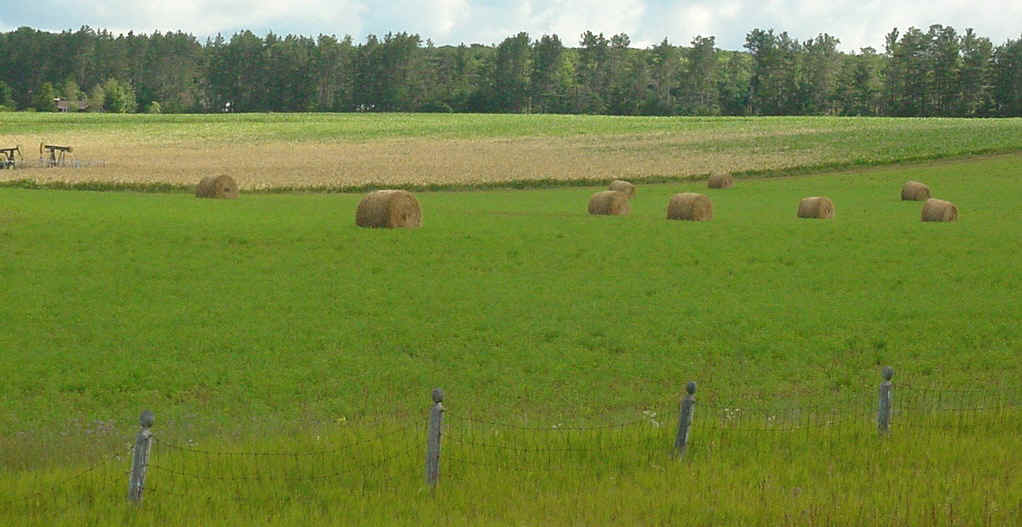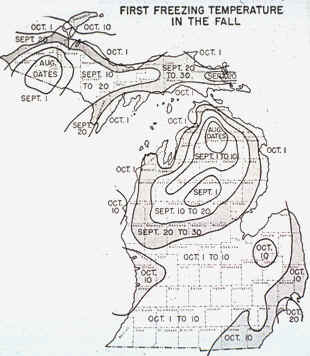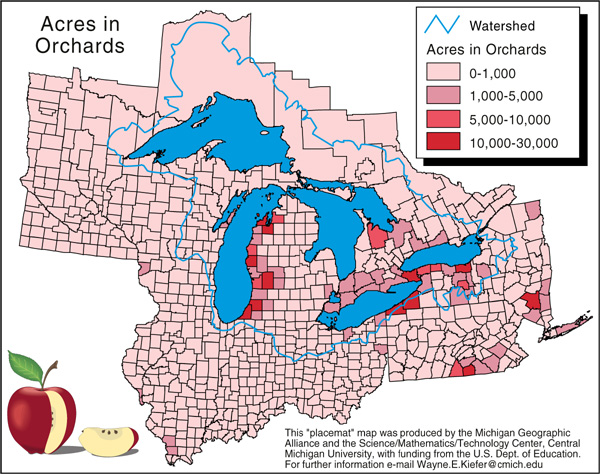GROWING SEASON LENGTH AND FROST
The length of the growing season is vital to many Michigan residents--not just to farmers.
The two major components of growing season length are the dates of the last frost
in spring and the first frost in fall.
Source: Hart, John Fraser (1991) “Part-Ownership and Farm Enlargement in the Midwest.” Annals of the Association of American Geographers 81 (1) , 66–79.

Source: Atlas
of Michigan, ed. Lawrence M. Sommers, 1977.
As the two maps above show, the length of growing season is variable, depending on the
years of data that are used to calculate it. For example, a map of growing season
length might look very different using 1930-1959 data, versus 1960-1989 data! Note
also that the area in the north-central lower peninsula, near Gaylord, has the shortest
growing season. True! The photo below shows a corn field frozen by a July 19, 2000 frost event! Note that the (yellowed) frozen
corn is only in the lowest part of the field, where the cold air "settled"
during the previous, cold, calm night.

Source:
Photograph by Randy Schaetzl, Professor of Geography - Michigan State University
The maps also illustrate the point that growing season is longest near
the lakes, primarily because the lakes delay the onset of the first fall frost (see
below). For example, whereas inland sites in the UP can expect frost in August, the
normal date of last frost on the tip of the Keweenaw peninsula (surrounded by
lake-moderated air) is mid-October.

Source: Unknown
In part because of the lengthened growing season near the lakes (lee sides only), many of these areas are now in fruit production, as the map below shows. Note that this pattern holds true not just for Michigan, but for the lee sides of most of the major lakes.

A late spring frost can be devastating to fruit growers, as is indicated by this late
April, 2000 article in the Grand Rapids Press:
Fruit farmers brace to face the frost
Thursday, April 27, 2000
By Dave Murray, The Grand Rapids Press
West Michigan fruit farmers are taking measures this week to
prevent a potentially devastating frost from damaging crops. Meteorologists say a high
pressure system camping over the Great Lakes region is offering spectacularly sunny days
but chilling nights, with temperatures plunging below the freezing point. That's trouble
for area farmers, with apples, blueberries, strawberries and other fruit plants that
are blooming this year and vulnerable to frost.
Phil Schwallier, a Michigan State University horticultural agent, said
he's recommending farmers take precautions -- typically irrigation and wind machines -- to
prevent frost from forming, especially in low areas. "The temperatures have
been cold, but they have not been as cold as expected," he said. "These are the
two or three weeks of the year that are critical. We've had frost as late as June in some
years, but that's unusual. This is the time of year where it's more likely. It's a very
critical time."
But the temperatures mean long nights and lots of pacing for area farmers. Apple farmer
Phil Succop, with 180 acres near Sparta, said he's up at 2 a.m. checking temperatures in
six different locations every 10 minutes. "There can be a 10-degree difference
between my high lands and low lands," he said. "Even 1 degree can make a big
difference." He's also checking for wind, which will help prevent frost from forming.
If the temperatures are below freezing and the air sock hangs limp, Succop said he will
use wind machines, which are large propellers sitting on 30-foot poles that direct warmer
air from the high areas to the colder lower regions. "It's a gamble, but it's
one worth taking," he said.
Randy Graham, a meteorologist for the National Weather Service, said a frost freeze
advisory remains in effect for all of southern Michigan. Graham said there is a high
pressure system camping over the Great Lakes that generates clear skies, light winds and
very dry air. "That's a situation that allows things to cool down quickly at
night," he said. "That's going to help things get below freezing, and widespread
frost is expected."
This material has been compiled for educational use only, and
may not be reproduced without permission. One copy may be printed for personal
use. Please contact Randall Schaetzl (soils@msu.edu)
for more information or permissions.